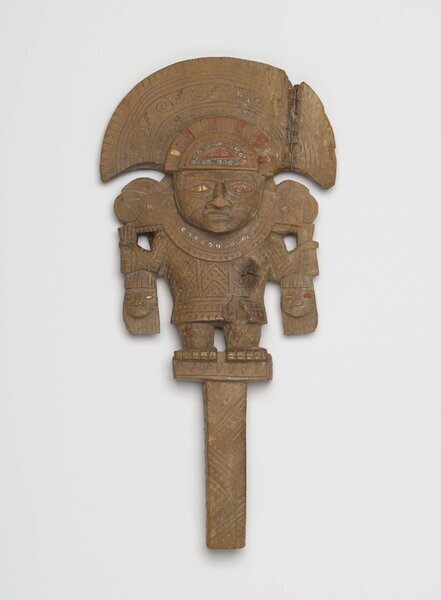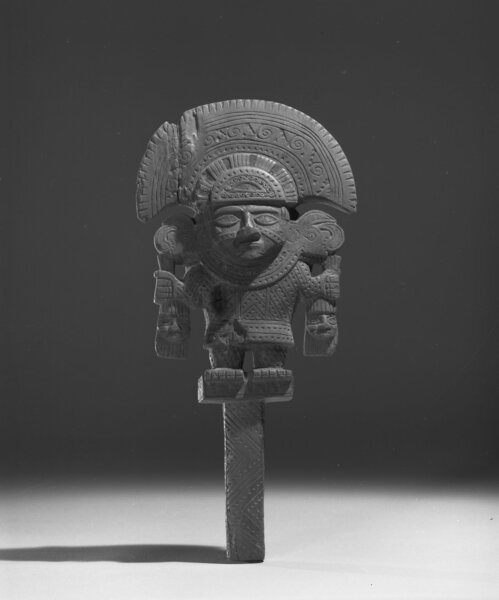Mirror Handle Item Number: 86.224.4 from the Brooklyn Museum


Description
Wooden mirror handle with carvings that portray a well-dressed individual, standing on a small pedestal, holding a trophy head in each hand. The individual wears a tunic with sleeves, a crescent-shaped headdress, and a collar with a serpent head. On the figure's tunic, headdress, legs, and elsewhere are triangles in relief. On the handle, collar, and headdress are turquoise bead inlays. Around the inlays are traces of red pigment. The eyes of the central figure as well as the eyes of the trophy heads are inlaid with thin sheets of gold that are covered over with red pigment. In the back of the carving is a shallow circular cavity which probably held a pyrite mirror. Condition: The front of the proper left side of the handle is damaged; the headdress of the central figure is chipped, broken, and repaired; the tunic has two gouges; the hair of each trophy head is chipped along the edges; the end of the handle is cracked. The object reveals overall surface wear.
Credit Line
Gift of the Ernest Erickson Foundation, Inc.
Label
This exquisitely carved Chimú mirror handle originally held a pyrite mirror in the concave area at the back. The object’s depiction of trophy heads (seen in the hands of the male figure) is rare for the period. The figure’s opulent attire, with a crescent headdress, serpent-headed collar, and sleeved tunic, indicates that he is a member of the ruling elite. Sacrificial victims have been found in high-status burials, and the trophy heads on this object may therefore allude to the status of the mirror’s owner.
Este mango de espejo Chimú exquisitamente tallado, originalmente sostenía un espejo de pirita en el área cóncava posterior. La representación de cabezas trofeo en este objeto (vistas en las manos de la figura masculina) es poco común en este periodo. La opulenta vestimenta de la figura, con un tocado de media luna, collar de serpiente bicéfala, y túnica con mangas, indica que era un miembro de la clase gobernante. Victimas sacrificadas se han encontrado en entierros de alta posición social, por lo que las cabezas trofeo en este objeto podrían aludir al rango del dueño del espejo.
Item History
- Made between 848 and 1472
What
- Name
- Mirror Handle
- Identification Number
- 86.224.4
- Type of Item
- mirror and handle
- Material
- wood, gold and red pigment
- Measurements
- “11 5/8 x 5 9/16 in. (29.5 x 14.1 cm)” ?
Who
- Culture
- Chimú
Where
- Holding Institution
- Brooklyn Museum
When
- Creation Date
- between 848 and 1472
Other
- Location
- Arts of the Americas Galleries, 5th Floor
- Classification
- Accessory